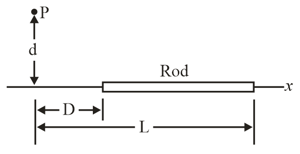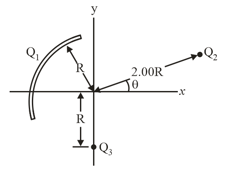A spherical drop of water carrying a charge of has a potential of at its surface (with at infinity). (a) What is the radius of the drop? (b) If two such drops of same charge and radius combine to form a single spherical drop, what is the potential at the surface of the new drop? (c) What is the ratio of the surface charge density on the new drop to that on the original drop?

Important Questions on Electric Potential
The figure shows a thin rod with a uniform charge density of . Evaluate the electric potential at the point if . Assume that the potential is zero at infinity.

The electric field in a region of space has the components and . The point is on the axis at and the point is on the axis at . What is the potential difference (in volt)?
In the figure, a plastic rod which has a uniformly distributed charge has been bent into a circular arc of a radius and the central angle . With at infinity, what is the electric potential at , the centre of curvature of the rod?

In the given figure, what is the net electric potential at the origin due to the circular arc of charge , the two particles of charges and ? The arc's centre of curvature is at the origin and its radius is , the angle indicated is . What is the net electric potential at the origin if both and are doubled?

